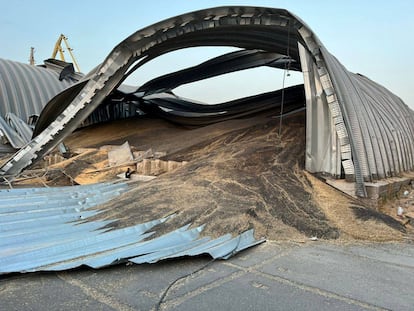Ukraine turns two artists into symbols of resistance against Russia
The Russian invasion has destroyed buildings containing the paintings of Maria Primachenko and Polina Raiko. Today, the works of these folkloric artists are being displayed in various exhibitions, in an attempt to strengthen the national Ukrainian identity
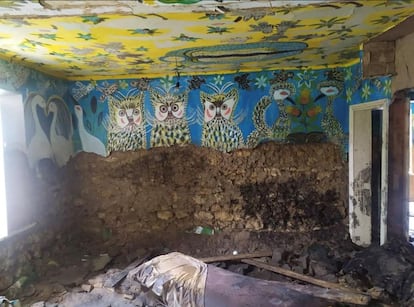

Someone has graffitied pro-European messages on the rubble of the destroyed local museum in the Ukrainian town of Ivankiv. “More Europe and less war,” the text reads, accompanied by the colors of the Ukrainian and EU flags.
The local museum in the Kyiv province was destroyed on February 25, 2022, by a Russian missile, just one day after the start of the invasion of Ukraine. It housed 14 paintings by its best-known local artist, Maria Primachenko (1909-1997). The heroic operation to save her work has become a symbol of the Ukrainian will to survive.
Far from Ivankiv — about 350 miles to the south, in the province of Kherson — the artistic work of Polina Raiko (1928-2004) was submerged this past June, under the waters of the Dnipro River. Her house was her magnum opus: all the walls were painted with figures from Ukrainian, religious and Soviet folklore. On June 6, the Kakhovka Dam — under Russian control — burst. Kyiv, the EU and Western intelligence services are all convinced that this catastrophe was the result of sabotage by the invading forces, in an attempt to stop the Ukrainian advance on the southern front. The flood washed away dozens of municipalities, as well as Raiko’s house in the village of Oleshki, which is located in territory that is occupied by Russia. The foundation that manages her body of work has been able to verify — through images taken by neighbors — that 70% of her paintings and murals are damaged or have disappeared.
Raiko — unlike Primachenko — was largely unknown until the recent disappearance of her work. But the impact that followed the misfortune has projected her as an example of the best Ukrainian folkloric art and, above all, as a symbol of resilience against an invader that wants to destroy the country. This summer, two exhibitions have been organized in Kyiv that reproduced Raiko’s paintings. One of them, in Ukraine House, one of the main exhibition spaces in the capital, was held next to an exhibition by Primachenko, the most-recognized national folkloric artist. An exhibition of Primachenko’s paintings is set to be held in Lviv, in the west of the country, by the end of the summer.
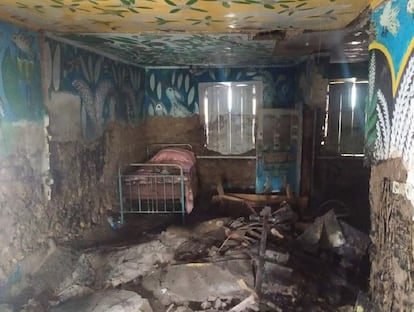
Raiko and Primachenko were women from the rural world. Their work was inspired by life in the countryside, inherited myths and boundless fantasy. In an essay published in 2021 by the Ivan Honchar Museum in Kyiv (where images of Raiko’s house are now on display), it was noted that folkloric art has been closely linked to Ukrainian identity since the 18th century.
The essay explains why so many samples of this kind of work are available today, despite the rife repression and destruction of art that took place when Ukraine was part of the Soviet Union: “The Soviet authorities frequently liquidated or silenced professional artists. However, naïve [folkloric] art was treated with respect. In Soviet times, naïve art was considered anonymous: it was believed that, like the people, it was a mass phenomenon, without individuality.”
The Primachenko Foundation, managed by her family, highlights the fact that, despite all the awards the artist received during the Soviet era, “the Soviet government wanted to suppress her voice.” When she was elderly, Primachenko painted numerous works that dealt with the 1986 Chernobyl nuclear catastrophe and the drama it entailed for the people of her region. Ivankiv is located only 30 miles from the nuclear power plant.
There’s a strong emotional connection between Ukrainian society and folkloric art. This can be detected in the public success of Primachenko’s exhibitions, or in the use of her images in contemporary clothing designs and patriotic slogans. For example, A dove has spread its wings and cries for peace, one of Primachenko’s best-known paintings, was used in 2022 as a symbol of campaigns that rallied international support for Ukraine.
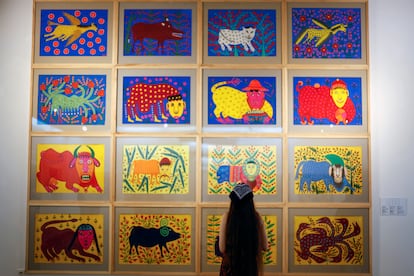
Eugene Bereznicki, director of the Bereznicki Foundation and promoter of the Kyiv Art Week festival, confirms that folkloric art has become a hallmark of Ukrainian identity, with people forging a visual connection. “Naïve art is very raw, very sincere… that makes it powerful. It’s part of the most basic Ukrainian identity.”
“What happens is that Ukrainians are now in the first phase of enjoying art,” Bereznicki continues. “It’s like when you give a child a toy for the first time and they don’t stop playing with it.”
The works of these artists are gaining value in the international market, Bereznicki adds, precisely because of their visual appeal and because they are recognized as the soul of Ukraine, a country that is on everyone’s lips due to the invasion. But her appeal began long ago. Primachenko was recognized for the first time globally in 1937, at the International Exhibition in Paris. She was discovered by the Franco-Ukrainian artist Alexandra Ekster; everyone from Chagall to Picasso was enthralled by her art. The latter declared that Primachenko was a genius. Despite the fact that she was a woman from the countryside living in the village of Bolotnia, her fame didn’t stop growing.
“Maria Primachenko wrote a new page in the history of Ukrainian cultural heritage,” her foundation notes, “and laid the foundations for a better understanding of national identity for new generations.” This vision — shared by the Ukrainian political establishment — made the salvation of her work in Ivankiv a matter of national pride. Such a sentiment was made explicit in the exhibition organized in September of 2022 at Ukraine House, with 14 of her pieces that were rescued from the Ivankiv museum prominently displayed. “The residents didn’t only save Primachenko’s paintings: they also saved the Ukrainian identity,” said the then-governor of the Kyiv province, Oleksiy Kuleba. He is now a senior official in President Zelenskiy’s administration.
“These paintings have become a symbol of the unity of Ukrainians in the joint defense of what they cherish,” says Anastasiia Primachenko, Maria’s great-granddaughter and representative of the family foundation. For Anastasiia, her great-grandmother’s work isn’t so much a symbol of resistance against Russia as “an awakening and revival of Ukrainian identity.”
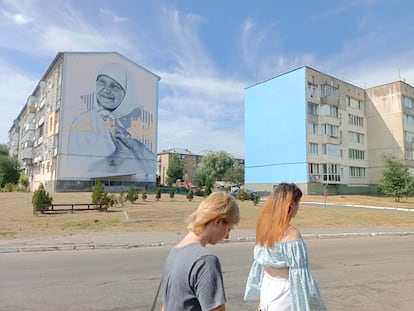
Yaroslav Kovalenko is 27 and lives just 300 feet away from the museum that was destroyed by the Russian missile. A child of Chernobyl, he was part of the groups of young people who would spend a few summers in Spain, to get away from the areas that were hardest hit by the nuclear accident. This law student explains that there were a few citizens who dared to jump into the flames to rescue the artworks. The paintings were then hidden, because Ivankiv was under Russian occupation. “Few were able to leave the village, because the Russians arrived here in the first days of the invasion and we didn’t know what was happening,” Kovalenko recalls. During the nearly two months of Russian occupation, he took refuge in his aunt’s country house. The signs of the devastation still remain: abandoned buildings in the town and, in the woods, warnings about the presence of landmines.
Bolotnia — the village adjoining Ivankiv, where Primachenko was born, lived and died — had no Russian military presence. According to several locals consulted, there was only one day when a group of soldiers appeared, asking if they had “alcohol, girls and saunas available.” Since the answer was negative, they returned to Ivankiv.
The Russians didn’t occupy the house where Primachenko was born, a beautiful one-story red brick building with a large garden and the smell of apple trees. Curtains that she embroidered herself still hang on the windows: her mother was a teacher of this art. As a girl, Primachenko studied at the tailoring school in Ivankiv. In 1936, when her talent was discovered, she was invited to study in Kyiv, at an experimental seminar on embroidery and artistic ceramics.
A few hundred feet from Primachenko’s estate, 77-year-old Lena Romanyuk and two friends — all dressed in brightly-colored smocks — express their hope that the Primachenko Foundation can carry out the project of turning the family home into a museum. Romanyuk, who is in charge of maintaining the painter’s grave, evokes her childhood, when Primachenko made dresses for her and other children in the village.
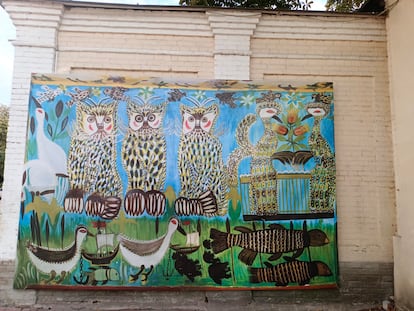
The residents of Bolotnia note that few people visit Primachenko’s house or grave. They tend to only come when there’s an anniversary being commemorated. And even fewer people will have visited Raiko’s home. She only started painting as therapy, to cope with severe family trauma, when she was 69. “It’s sad, but misfortunes often reveal artists who were undervalued,” Bereznicki sighs. Raiko’s house — which was photographed inch by inch in 2013 by the Ivan Honchar museum — will be rebuilt in another location. “Polina Raiko’s house will be another museum of the war — it will be a symbol of what has happened,” the curator affirms.
Raiko’s house also has its hero. Kherson-based artist Viacheslav Mashnitskyi, director of the Raiko Foundation, decided to stay in the Russian-occupied territory to safeguard her legacy. His family and friends in free Ukraine haven’t heard from him for almost a year.
Sign up for our weekly newsletter to get more English-language news coverage from EL PAÍS USA Edition
Tu suscripción se está usando en otro dispositivo
¿Quieres añadir otro usuario a tu suscripción?
Si continúas leyendo en este dispositivo, no se podrá leer en el otro.
FlechaTu suscripción se está usando en otro dispositivo y solo puedes acceder a EL PAÍS desde un dispositivo a la vez.
Si quieres compartir tu cuenta, cambia tu suscripción a la modalidad Premium, así podrás añadir otro usuario. Cada uno accederá con su propia cuenta de email, lo que os permitirá personalizar vuestra experiencia en EL PAÍS.
¿Tienes una suscripción de empresa? Accede aquí para contratar más cuentas.
En el caso de no saber quién está usando tu cuenta, te recomendamos cambiar tu contraseña aquí.
Si decides continuar compartiendo tu cuenta, este mensaje se mostrará en tu dispositivo y en el de la otra persona que está usando tu cuenta de forma indefinida, afectando a tu experiencia de lectura. Puedes consultar aquí los términos y condiciones de la suscripción digital.
More information
Archived In
Últimas noticias
There is as much life left to discover on planet Earth as that which is already known
Dozens presumed dead, around 100 injured in fire at Swiss Alps bar during New Year’s celebration
Is porn for women different from conventional porn? We spoke to those who make it
Cartagena de Indias is sinking: What can the city do to mitigate it?
Most viewed
- Reinhard Genzel, Nobel laureate in physics: ‘One-minute videos will never give you the truth’
- Sinaloa Cartel war is taking its toll on Los Chapitos
- David King, chemist: ‘There are scientists studying how to cool the planet; nobody should stop these experiments from happening’
- Oona Chaplin: ‘I told James Cameron that I was living in a treehouse and starting a permaculture project with a friend’
- The Interoceanic Train, the Mexican alternative to the Panama Canal
